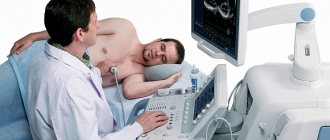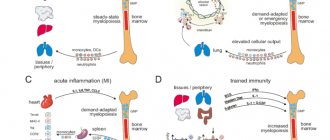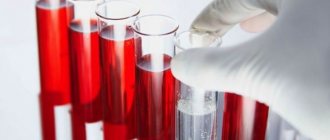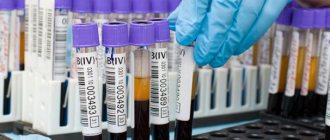Electrocardiogram (ECG): interpretation of results
By: Administrator |
Tags: decoding ECG results, decoding ECG, ECG, ECG normal, Electrocardiogram, electrocardiogram decoding results | Comments: | June 24, 2021 Electrocardiography is a simple and informative study that determines heart rate indicators. A cardiograph records heart activity and records its parameters on paper. To evaluate them and draw conclusions about the patient’s condition, it is necessary to decipher the cardiogram. ECG interpretation is performed manually by comparing the characteristics of the graph with special tables or using computer programs to interpret the ECG results.
What concepts are used when decoding
Decoding an ECG is a rather complex process that requires deep knowledge from a specialist. During the assessment of the heart condition, the cardiogram parameters are measured mathematically. In this case, concepts such as sinus rhythm, heart rate, electrical conductivity and electrical axis, pacemakers and some others are used. By assessing these indicators, the doctor can clearly determine some parameters of the functioning of the heart.
Heart rate
Heart rate is a specific number of heart beats over a certain period of time. Typically an interval of 60 seconds is taken. On a cardiogram, heart rate is determined by measuring the distance between the tallest teeth (R - R). The recording speed of the graphic curve is usually 100 mm/s. By multiplying the recording length of one mm by the duration of the segment R – R, the heart rate is calculated. In a healthy person, the heart rate should be 60 - 80 beats per minute.
Sinus rhythm
Another concept included in the interpretation of the ECG is the sinus rhythm of the heart. During normal functioning of the heart muscle, electrical impulses arise in a special node, then spread to the area of the ventricle and atrium. The presence of sinus rhythm indicates normal functioning of the heart.
The cardiogram of a healthy person should show the same distance between the R waves throughout the entire recording. A deviation of 10% is allowed. Such indicators indicate the absence of arrhythmia in a person.
Conduction Paths
This concept defines a process such as the propagation of electrical impulses through the tissues of the heart muscle. Normally, impulses are transmitted in a certain sequence. Violation of the order of their transfer from one pacemaker to another indicates organ dysfunction and the development of various blockades. These include sinoatrial, intraatrial, atrioventricular, intraventricular blocks, as well as Wolff-Parkinson-White syndrome.
On an ECG, a specialist can see a violation of cardiac conduction
Electrical axis of the heart
When deciphering a cardiogram of the heart, the concept of the electrical axis of the heart is taken into account. This term is widely used in cardiological practice. When interpreting an ECG, this concept allows a specialist to see what is happening in the heart. In other words, the electrical axis is the totality of all biological and electrical changes within an organ.
An electrocardiogram allows you to visualize what is happening in a specific area of the heart muscle using a graphic image obtained by transmitting impulses from electrodes to a special device.
The position of the electrical axis is determined by the doctor using special diagrams and tables or by comparing the QRS complexes, which are responsible for the process of excitation and contraction of the cardiac ventricles.
If ECG indicators indicate that the R wave in lead III has a smaller amplitude than in lead I, we are talking about a deviation of the cardiac axis to the left. If in lead III the R wave has a greater amplitude than in lead I, it is customary to speak of axis deviation to the right. Normal indicators in the cardiogram table are the highest R wave in lead II.
Teeth and intervals
On the cardiogram itself obtained during the study, the waves and intervals are not indicated. They are needed only for the specialist doing the decryption.
Prongs:
- P – determines the beginning of contraction of the atrium;
- Q, R, S – belong to the same type, coincide with the contraction of the ventricles;
- T – time of inactivity of the ventricles of the heart, that is, their relaxation;
- U - rarely noted on the cardiogram; there is no consensus on its origin.
For ease of interpretation, the cardiogram is divided into intervals. On the tape you can see straight lines that run clearly in the middle of the tooth. They are called isolines or segments. When making a diagnosis, indicators of the P – Q and S – T segments are usually taken into account.
In turn, one interval consists of segments and teeth. The length of the interval also helps assess the overall picture of heart function. The intervals P - Q and Q - T have diagnostic significance.
Important! You cannot read a cardiogram yourself without certain knowledge. Decoding of the cardiogram is carried out exclusively by a specialist.
Mobitz I
This type of blockade of the second type can be physiological for young people and athletes. On the ECG it appears as an increase in the PQ interval with each contraction. The interval increases until the atrial impulse is blocked (this is shown on the cardiogram as the absence of the QRS complex).
Also, as with the first type of blockade, patients may not suspect the presence of disturbances in the conduction system of the heart and may not experience any clinically manifested symptoms.
If a second-degree block of Mobitz type I is detected, a re-examination should be carried out , including 24-hour heart rate monitoring and a repeat electrocardiogram. Treatment is prescribed after identifying the cause of the blockade.
Reading a cardiogram
How to decipher a cardiogram of the heart? This question is asked by many patients who have had to deal with the electrocardiography procedure. It is very difficult to do this yourself, because decrypting data has a lot of nuances. And if you read certain disturbances in the activity of the heart in your cardiogram, this does not at all mean the presence of this or that disease.
A cardiologist reads a cardiogram
Prongs
In addition to taking into account intervals and segments, it is important to monitor the height and duration of all teeth. If their fluctuations do not deviate from the norm, this indicates healthy functioning of the heart. If the amplitude is deviated, we are talking about pathological conditions.
Norm of waves on an ECG:
- P – should have a duration of no more than 0.11 s., a height within 2 mm. If these indicators are violated, the doctor can make a conclusion about a deviation from the norm;
- Q – should not be higher than a quarter of the R wave, wider than 0.04 s. Particular attention should be paid to this tooth; its deepening often indicates the development of myocardial infarction in a person. In some cases, tooth distortion occurs in people with severe obesity;
- R – when deciphered, it can be traced in leads V5 and V6, its height should not exceed 2.6 mV;
- S is a special tooth for which there are no clear requirements. Its depth depends on many factors, for example, weight, gender, age, body position of the patient, but when the tooth is too deep, we can talk about ventricular hypertrophy;
- T – must be at least a seventh of the R wave.
In some patients, after the T wave on the cardiogram, a U wave appears. This indicator is rarely taken into account when making a diagnosis and does not have any clear standards.
Segments and Intervals
Intervals and segments also have their own normal values. If these values are violated, the specialist usually gives a referral to the person for further research.
Normal indicators:
- The ST segment should normally be located directly on the isoline;
- The QRS complex should not last more than 0.07 - 0.11 s. If these indicators are violated, various pathologies of the heart are usually diagnosed;
- the PQ interval should last from 0.12 milliseconds to 0.21 seconds;
- The QT interval is calculated taking into account the heart rate of a particular patient.
Segments and Intervals
Important! The ST segment in leads V1 and V2 sometimes runs slightly above the baseline. The specialist must take this feature into account when deciphering the ECG.
PQ interval pathologies
Changes in the PQ interval indicate pathologies of the cardiac conduction system. This interval can be either shortened or lengthened. In some cases, there is dissociation of the P wave from the QRS complex.
A shortening of the interval indicates a faster than normal conduction of excitation from the atria to the ventricles. This can be dangerous due to the development of tachycardia attacks.
Lengthening the interval, on the contrary, indicates difficulty in conducting excitation between the atria and ventricles. These pathologies are called atrioventricular conduction blocks. They are classified as both physiological and pathological.
Pathologies of the PQ interval are fraught with the development of tachycardia
A shortening of the interval may indicate the presence of premature ventricular excitation syndrome. This syndrome is associated with the presence of additional (abnormal) pathways through which excitation from the atria reaches the ventricles. As a result, the impulse spreads without physiological delay, faster than necessary.
There are two types of this syndrome: CLC syndrome and WPW syndrome ; they can be differentiated from each other by the characteristics of the QRS complexes. You can recognize accelerated impulse conduction on an ECG by measuring the duration of the PQ interval. Its normal values should be less than 0.11 seconds.
The PQ interval on the ECG (the norm for children is less than for adults) during diagnosis depends on the age of the patients. With this pathology, the QRS complex and the T wave remain unchanged.
The danger of this phenomenon is the possibility of developing arrhythmias (paroxysmal tachycardias). During the course of the disease without attacks of tachycardia, the patient may not realize for a long time that there are additional pathways in the heart.
An increase in the interval may occur in cases of atrioventricular blockade. There are partial (types 1 and 2) and complete (type 3) blockades. The cause of blockades can be functional or organic factors.
Functional reasons include the use of certain medications that reduce intracardiac conduction and intense exercise. Examples of organic causes are myocardial infarction, infectious diseases of the heart muscle, myocardial ischemia and heart defects.
Intense sports may cause the development of PQ interval pathologies
The PQ interval on the ECG (the norm against the background of partial blockades is violated) in the first type increases, since the conduction of excitation is slowed down, but all impulses from the atria reach the ventricles. This type of blockade is physiological and is quite often observed in young patients and athletes.
Often this type of blockade has no clinical manifestations and does not affect people’s daily lives. On the ECG, this type of blockade manifests itself as an increase in the PQ interval (duration more than 0.2 s).
If a blockade of this type is detected, it is advisable to undergo additional examination to exclude the possibility of concomitant pathologies. Treatment is not prescribed until the factors that trigger the development of the pathology are identified.
PQ interval on ECG - pathologies
In the second type of disorder, not all impulses from the atria reach the ventricles. The ECG recording clearly shows that there are no QRS complexes following some P waves. There are two variants of the manifestation of the second type of blockade: Mobitz I and Mobitz II.
Decryption features
To record a cardiogram, special sensors are attached to a person’s body, which transmit electrical impulses to an electrocardiograph. In medical practice, these impulses and the paths they take are called leads. Basically, 6 main leads are used during the study. They are designated by the letters V from 1 to 6.
The following rules for deciphering a cardiogram can be distinguished:
- In lead I, II or III, you need to determine the location of the highest region of the R wave, and then measure the gap between the next two waves. This number should be divided by two. This will help determine the regularity of your heart rate. If the gap between the R waves is the same, this indicates normal contraction of the heart.
- After this, you need to measure each tooth and interval. Their standards are described in the article above.
Most modern devices automatically measure your heart rate. When using older models, this has to be done manually. It is important to consider that the ECG recording speed is usually 25 – 50 mm/s.
Heart rate is calculated using a special formula. At an ECG recording speed of 25 mm per second, it is necessary to multiply the R - R interval distance by 0.04. In this case, the interval is indicated in millimeters.
At a speed of 50 mm per second, the R - R interval must be multiplied by 0.02.
For ECG analysis, 6 of 12 leads are usually used, since the next 6 duplicate the previous ones.
Normal values in children and adults
In medical practice, there is the concept of an electrocardiogram norm, which is typical for each age group. Due to the anatomical characteristics of the body in newborns, children and adults, the study indicators are slightly different. Let's take a closer look at them.
ECG norms for adults can be seen in the figure.
Normal ECG in adult patients
A child's body is different from an adult's. Due to the fact that the organs and systems of the newborn are not fully formed, electrocardiography data may differ.
In children, the mass of the right ventricle of the heart prevails over the left ventricle. Newborns often have a high R wave in lead III and a deep S wave in lead I.
The ratio of the P wave to the R wave in adults is normally 1:8; in children, the P wave is tall, often more pointed, in relation to R is 1:3.
Due to the fact that the height of the R wave is directly related to the volume of the ventricles of the heart, its height is lower than in adults.
Mobitz II
This type is always pathological. The pulse travel time is constant, but the pulses are periodically blocked. This is reflected as the absence of some QRS complexes. Most often, a violation of the passage occurs on every third (3:1) or fourth (4:1) excitation. In severe cases, the blockade occurs every second contraction (2:1).
The condition of patients with this pathology can be very different. Some patients note a sharp deterioration in their condition, darkening of the eyes, coinciding with the loss of the QRS complex. A number of patients may not even be aware of the presence of these problems.
The severity of the blockade and the risk of transition to a complete blockade (third degree blockade) depends on the causes of the development of the pathology. Treatment is also prescribed based on the etiology of the disease. Blockade of the third type is characterized by complete disruption of impulse conduction. On the cardiogram, this appears as a separation between the P waves and the QRS complexes.
Cardiac activity in such patients is maintained by the rhythm generated by the ventricles. Depending on the cause of the development of third-degree blockade, treatment methods can be either medicinal or surgical (implantation of a pacemaker). If this type of block is congenital, most patients do not require a pacemaker.
Disturbances in the conduction system of the heart can cause sudden cardiac arrest and death. These disorders can be either congenital or acquired.
In the case of acquired diseases, early diagnosis and correctly prescribed treatment can affect a favorable outcome of the disease. That is why an ECG should be performed periodically to make sure that its indicators (in particular the PQ interval) are normal.
What affects the accuracy of indicators
Sometimes the results of a cardiogram may be erroneous and differ from previous studies. Errors in results are often associated with many factors. These include:
- incorrectly attached electrodes. If the sensors are poorly attached or become dislodged during an ECG, the test results can be seriously affected. That is why the patient is recommended to lie still during the entire period of taking the electrocardiogram;
- extraneous background. The accuracy of the results is often influenced by extraneous devices in the room, especially when the ECG is performed at home using mobile equipment;
- smoking, drinking alcohol. These factors affect blood circulation, thereby changing the cardiogram parameters;
- meal. Another reason that affects blood circulation and, accordingly, the correctness of indicators;
- emotional experiences. If the patient is worried during the study, this may affect the heart rate and other indicators;
- Times of Day. When conducting a study at different times of the day, the indicators may also differ.
The specialist must take into account the above-described nuances when interpreting the ECG; if possible, they should be excluded.
How to make an appointment with a cardiologist
- It is advisable to undergo an ECG with interpretation and get advice from a qualified doctor by visiting a diagnostic and treatment center. Regular customers note the following benefits of service:
- Modern diagnostic equipment, which makes it possible to obtain an accurate diagnosis and speed up the examination.
- Patients are advised and accompanied by specialists with scientific degrees, doctors of the highest category with many years of practice.
- Carrying out an ECG in the clinic or at home, issuing the result immediately after the study.
- Completion of the study on the day of treatment or any convenient time.
To make an appointment with a cardiologist, just use the feedback button on the Loritom clinic website.
Dangerous diagnoses
Diagnostics using electrical cardiography helps to identify many cardiac pathologies in a patient. Among them are arrhythmia, bradycardia, tachycardia and others.
Cardiac conduction disorder
Normally, the electrical impulse of the heart passes through the sinus node, but sometimes a person has other pacemakers. In this case, symptoms may be completely absent. Sometimes conduction disturbances are accompanied by rapid fatigue, dizziness, weakness, surges in blood pressure and other symptoms.
Cardiac conduction abnormalities on ECG
In asymptomatic cases, special therapy is often not required, but the patient should undergo regular examinations. Many factors can negatively affect the functioning of the heart, which entails disruption of depolarization processes, decreased myocardial nutrition, development of tumors and other complications.
Bradycardia
A common type of arrhythmia is bradycardia. The condition is accompanied by a decrease in heart rate below normal (less than 60 beats per minute). Sometimes such a rhythm is considered normal, which depends on the individual characteristics of the body, but more often bradycardia indicates the development of one or another heart pathology.
Features of the ECG in a patient with bradycardia can be seen in the figure.
Bradycardia on the cardiogram
There are several types of disease. For latent bradycardia without obvious clinical signs, therapy is usually not required. In patients with severe symptoms, the underlying pathology causing the heart rhythm disturbance is treated.
Extrasystole
Extrasystole is a condition accompanied by untimely contraction of the heart. In the patient, extrasystole causes a sensation of a strong cardiac impulse, a sensation of cardiac arrest. At the same time, the patient experiences fear, anxiety, and panic. The prolonged course of this condition often leads to impaired blood flow, entailing angina pectoris, fainting, paresis and other dangerous symptoms.
It is believed that with extrasystole no more than 5 times per hour there is no danger to health, but if attacks occur more often, appropriate treatment should be carried out.
Sinus arrhythmia
The peculiarity of this disorder is that when the heart rate changes, the work of the organ remains coordinated, the sequence of contractions of the heart parts remains normal. Sometimes, in a healthy person, sinus arrhythmia can be observed on an ECG under the influence of factors such as food intake, anxiety, and physical activity. In this case, the patient does not experience any symptoms. Arrhythmia is considered physiological.
In other situations, this disorder may indicate pathologies such as coronary heart disease, myocardial infarction, myocarditis, cardiomyopathy, and heart failure.
Patients may notice symptoms in the form of headaches, dizziness, nausea, heart rhythm disturbances, shortness of breath, and chronic fatigue. Treatment of sinus arrhythmia involves getting rid of the underlying pathology.
Norm and signs of arrhythmia on a cardiogram
Important! In children, sinus arrhythmia often occurs during adolescence and may be associated with hormonal imbalances.
Tachycardia
With tachycardia, the patient experiences an increase in heart rate, that is, more than 90 beats per minute. Normally, tachycardia develops in people after intense physical exertion; sometimes stress can cause palpitations. In a normal state, the rhythm is normalized without consequences for health.
It is important to note that tachycardia is not an independent disease and does not occur on its own. This disorder always acts as a secondary symptom of some pathology. This means that treatment should be aimed at the disease causing the increased heart rate.
Indications for ECG
ECG is a non-invasive and painless research method that has no contraindications. The procedure is carried out on a planned or emergency basis.
Planned electrocardiography is prescribed:
- before surgical interventions;
- during pregnancy;
- during preventive examinations of the population;
Scheduled electrocardiography is prescribed in certain cases.
Also, periodic electrocardiography must be performed for persons with health conditions or occupational hazards:
- in the presence of atherosclerotic plaques;
- hypertension;
- elevated blood cholesterol levels;
Emergency electrocardiography is performed to identify pathological processes in the heart, some of which require immediate intervention.
An emergency ECG is prescribed for:
- sharp pain localized behind the sternum or in the upper abdomen;
- sudden onset of shortness of breath;
- heart murmurs identified during initial diagnosis;
- with discomfort in the heart.











